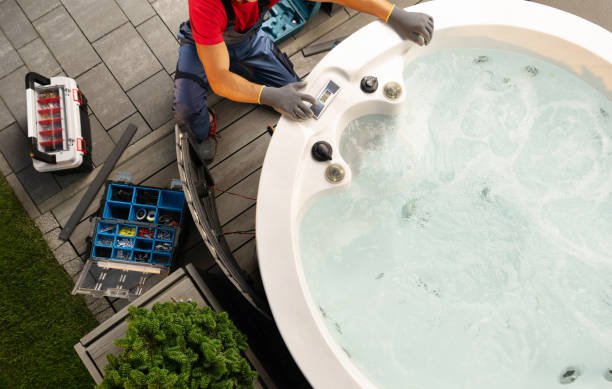Hot tubs offer the perfect way to relax, relieve muscle tension, and enjoy hydrotherapy from the comfort of your home. But when something goes wrong, the experience quickly turns stressful. While some minor issues can be managed with routine maintenance, others require professional repair to prevent further damage.
Knowing when it’s time to call a technician can save you from costly replacements and keep your hot tub in top condition. In this guide, we’ll explore the top signs that you needsprofessional hot tub needs repair, what they mean, and why fast action matters.
1. Water Isn’t Heating Properly
A common but serious sign of trouble is when your hot tub water fails to reach the desired temperature—or won’t heat at all. This could be caused by:
-
A faulty heating element
-
Malfunctioning thermostat
-
Electrical issues
-
Flow restrictions due to dirty filters
You should never attempt to fix spa heater problems yourself, as they involve electrical systems that can be dangerous without proper training.
Professional repair services can quickly diagnose and replace defective components, ensuring safe operation.
2. Jets Aren’t Working as They Should
Jets are the core feature of most hot tubs, and when they become weak, inconsistent, or non-functional, it’s a clear signal that something’s off.
Common jet-related issues include:
-
Airlock in the plumbing
-
Clogged or broken nozzles
-
Faulty circulation pump
-
Electrical relay problems
A technician can flush the system, inspect the hot tub pump system, and replace damaged parts to restore optimal performance.
3. Unusual Noises from the Pump or Motor
If you hear humming, grinding, or screeching sounds, your hot tub is trying to tell you something. These noises usually stem from:
-
Worn motor bearings
-
Debris caught in the impeller
-
Cavitation (air in the pump)
-
Motor overheating
Ignoring these sounds can lead to motor burnout or water flow loss. It’s best to shut off the unit and book a professional diagnosis immediately.
Don’t let minor noises turn into major repairs—address them early with certified spa technicians.
4. Water Leaks Around the Hot Tub
Leaks can appear around:
-
Plumbing connections
-
Pump seals
-
Jet fittings
-
Heater unions
-
Cracked shell or cabinet
Some leaks are obvious, but others can remain hidden behind panels, slowly damaging electrical components or the spa’s foundation.
Signs of leaks:
-
Water pooling near the hot tub base
-
Frequently low water levels
-
Mold or mildew smells
-
Damp insulation
Professional leak detection tools (like dye tests or thermal imaging) help locate hidden issues that DIY inspections might miss.
5. Frequent Tripping of Circuit Breakers
A tripped breaker now and then isn’t necessarily alarming. But if your spa repeatedly cuts power, it could point to a:
-
Short circuit
-
Faulty GFCI
-
Water intrusion in electrical components
-
Overheating pump or heater
This is not a DIY-friendly problem—handling hot tub wiring requires knowledge of both spa design and electrical safety codes.
A licensed repair professional can safely resolve wiring issues and prevent fire hazards or equipment damage.
6. Control Panel Error Codes
Modern hot tubs display error codes to alert you of system malfunctions. Some of the most common include:
-
FLO / FL (flow issues)
-
OH (overheating)
-
DR (dry heater or low water)
-
HL / HH (high-limit thermostat errors)
While some codes can be reset with simple filter cleaning or water refills, others indicate serious system failures. A technician can interpret the code and inspect the necessary parts.
7. Strong Chemical Smells or Cloudy Water
If your spa water looks murky or smells like chemicals—even after balancing the pH—it could mean:
-
Poor filtration
-
Biofilm buildup in the plumbing
-
Overworked or failing ozone/UV systems
-
Bacterial growth
Poor water quality not only damages spa components but can pose health risks. A professional service can clean the plumbing lines, drain and refill the tub, and test equipment to restore healthy water chemistry.
8. Cracks in the Hot Tub Shell or Cabinet
Small cracks may seem cosmetic, but they often lead to:
-
Water leaks
-
Structural damage
-
Insulation issues
-
Mold buildup in the shell
Spa technicians can assess whether the crack is repairable or if a section of the unit needs replacement.
9. Spa Won’t Turn On at All
If your spa won’t power up:
-
Check your breaker box and GFCI first
-
Try resetting the control panel
-
Look for signs of tripped sensors or overheated components
If none of these basic steps work, it’s time for expert help. The issue could be with the transformer, circuit board, or power supply.
3 Bolded Secondary Keywords
-
Hot tub pump system
-
Certified spa technicians
-
Professional repair services
10. Scheduled Maintenance Is Overdue
Sometimes, it’s not a visible problem that tells you it’s time for repair—it’s the calendar. Regular maintenance by a technician can catch:
-
Worn components
-
Slow leaks
-
Poor water flow
-
Electrical fatigue
If it’s been more than 6–12 months since your last service visit, your hot tub might be silently suffering from internal wear.
Why Early Repairs Save Money
Delaying hot tub repairs often leads to:
-
Higher energy bills
-
Mold and mildew issues
-
Damage to electronic controls
-
Full component replacements instead of small fixes
By responding early to warning signs, you protect your investment and extend the life of your hot tub.
FAQs
1. How often should I inspect my hot tub for issues?
A visual inspection every 1–2 weeks and routine maintenance every 3–4 months can help you catch problems early.
2. Can I fix a broken jet myself?
Sometimes. If it’s just clogged, you can clean it. But if it’s damaged or linked to plumbing issues, it’s best to call a pro.
3. Is cloudy water always a sign of a problem?
Yes. Cloudy water usually indicates poor filtration, high pH, or failing sanitization equipment.
4. What’s the average cost for hot tub repair in the USA?
Repairs typically range from $150–$600 depending on the issue. Leak detection or electrical problems may cost more.
5. Can I keep using my spa if it has a small leak?
No. Even a small leak can cause serious internal damage, especially to wood frames or electrical components.
Conclusion
Your hot tub is more than a luxury—it’s a system of complex components that must work together. By staying alert to the top signs of trouble, such as heating issues, non-working jets, odd sounds, or leaks, you can act early and avoid expensive disasters.
When in doubt, rely on professional jacuzzi repair services and certified spa technicians to safely restore your spa. Your peace of mind—and long-term spa health—are worth the call.








